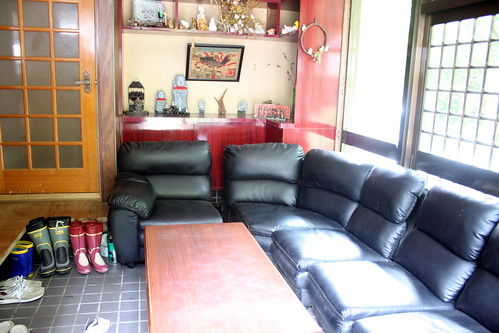Friday, July 13, 2012
Japanese Entrance Hall (Genkan) with Sofa
A genkan is a entrance hall, at a slightly lower level to the rest of the house which is raised, where people take off their shoes before entering the home. It is also used as a place to display ornaments and sometimes as a place to briefly entertain casual visitors. It is not uncommon for householders to kneel in the corridor just beyond their genkan, while their visitor stands on the lower genkan floor.
To make casual visitors feel more comfortable, this (very unusual) home in a Buddhist temple's grounds has a three piece suite in the genkan, so that the monk can entertain without allowing visitors into the home.
The home is considered more private in Japan and entrance to other people's homes is more often avoided. House parties are a rarity and generally limited to extended family members.
Entrance to another persons home, and the further one enters into that space, implies a greater degree of social intimacy. Nakane (1972) argues that Japanese groups, including the family, are considered to be bound together not by virtue of shared concepts such as common goals, or mutual love -- though of course they usually love each other -- but by their membership to, and ability to enter a shared frame, or place, such as the home. Family members refer to each other as "our place's bride' (uchi no yomesan) 'our place's granny," (uchi no obaasan), or "our place's leader" (uchi no danna) meaning husband or patriarch. Marriage ceremonies are said to take place between homes or houses in a way reminiscent of marriages between European aristocracy*. Entering a Japanese person's home, to its depths at least, implies that one is a member of the family (see Bachnik and Quinn, 1994). These customs are indicative of the way in which the home is considered to be a special, semi-sacred space centred around the household altars (kamidana and bustudan), and as such an important vector of social cohesion.
Notes
* see e.g. the marriage between the House of Burgundy and the House of La Marck
Bibliography
Bachnik, J. M., & Quinn, C. J. (Eds.). (1994). Situated Meaning: Inside and Outside in Japanese Self, Society, and Language. Princeton University Press.
Nakane, C. (1972). Japanese Society (1st pb ed.). University of California Press.
Labels: nihobunka, nihonbunka, 日本文化
This blog represents the opinions of the author, Timothy Takemoto, and not the opinions of his employer.

